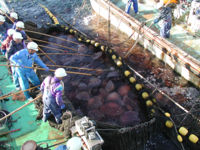Nemopilema nomurai: Difference between revisions
No edit summary |
No edit summary |
||
| Line 1: | Line 1: | ||
[[Image:Nemopilema_nomurai_net.jpg|right|thumb|200px|Nemopilema nomurai being pushed out of a set net by fishermen with bamboo poles, 2005]]'''Nemopilema nomurai''' is a large rhizostome jellyfish that grows to approximately 200 cm bell diameter and 200 kg wet weight. It is probably distributed predominantly in the northern East China Sea, Yellow Sea, and Bohai Sea, but may also be advected northward by the Tsushima Current into the Sea of Japan. For most of the last century, it was not abundant in the coastal waters of Japan; during such 'normal' years (e.g. 2001) only one or two medusae per week were caught in any particular set-net. In contrast, N. nomurai occurred at exceptional abundances around Japan during 1920, 1958, 1995, 2002, 2003, 2005, and 2006; during such 'bloom' years up to 1500 medusae have been caught in a set-net in a single day. Preliminary observations in the Tsushima Current during May-June 2007 indicate the largest bloom since 2002 is currently on its way toward Japan. | [[Image:Nemopilema_nomurai_net.jpg|right|thumb|200px|Nemopilema nomurai being pushed out of a set net by fishermen with bamboo poles, 2005]]'''Nemopilema nomurai''' is a large rhizostome jellyfish that grows to approximately 200 cm bell diameter and 200 kg wet weight. It is probably distributed predominantly in the northern East China Sea, Yellow Sea, and Bohai Sea, but may also be advected northward by the Tsushima Current into the Sea of Japan. For most of the last century, it was not abundant in the coastal waters of Japan; during such 'normal' years (e.g. 2001) only one or two medusae per week were caught in any particular set-net. In contrast, N. nomurai occurred at exceptional abundances around Japan during 1920, 1958, 1995, 2002, 2003, 2005, and 2006; during such 'bloom' years up to 1500 medusae have been caught in a set-net in a single day. Preliminary observations in the Tsushima Current during May-June 2007 indicate the largest bloom since 2002 is currently on its way toward Japan. | ||
Although Nemopilema nomurai is edible, it is considered a low-quality food because it does not have the preferred crunchy texture of good 'kurage'. Consequently, rather than being a boon for jellyfish fisheries, the blooms of Nemopilema nomurai have been most notable for the problems they have caused in Japan. These problems include | |||
*clogging and bursing of nets; | |||
*lower catches of finfish,; | |||
*high mortality of finfish due to invenomation by the jellyfish; | |||
*reduced commercial value of finfish due to invenomation; | |||
*increased labour costs associated with removal of the medusae from nets (see figure above); | |||
*increased risk of capsizing trawlers; | |||
*the short-term inconvenience and discomfort caused by stings suffered by fishermen. | |||
Revision as of 15:54, 13 August 2008
Nemopilema nomurai is a large rhizostome jellyfish that grows to approximately 200 cm bell diameter and 200 kg wet weight. It is probably distributed predominantly in the northern East China Sea, Yellow Sea, and Bohai Sea, but may also be advected northward by the Tsushima Current into the Sea of Japan. For most of the last century, it was not abundant in the coastal waters of Japan; during such 'normal' years (e.g. 2001) only one or two medusae per week were caught in any particular set-net. In contrast, N. nomurai occurred at exceptional abundances around Japan during 1920, 1958, 1995, 2002, 2003, 2005, and 2006; during such 'bloom' years up to 1500 medusae have been caught in a set-net in a single day. Preliminary observations in the Tsushima Current during May-June 2007 indicate the largest bloom since 2002 is currently on its way toward Japan.
Although Nemopilema nomurai is edible, it is considered a low-quality food because it does not have the preferred crunchy texture of good 'kurage'. Consequently, rather than being a boon for jellyfish fisheries, the blooms of Nemopilema nomurai have been most notable for the problems they have caused in Japan. These problems include
- clogging and bursing of nets;
- lower catches of finfish,;
- high mortality of finfish due to invenomation by the jellyfish;
- reduced commercial value of finfish due to invenomation;
- increased labour costs associated with removal of the medusae from nets (see figure above);
- increased risk of capsizing trawlers;
- the short-term inconvenience and discomfort caused by stings suffered by fishermen.
